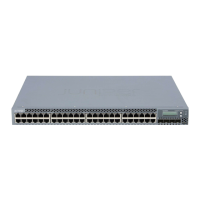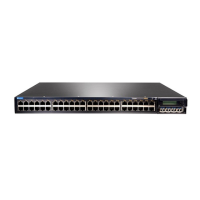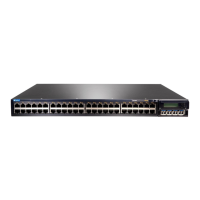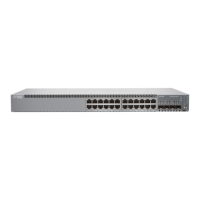Efficient device operation requires proper site planning and maintenance and proper
layout of the equipment, rack or cabinet (if used), and wiring closet.
To plan and create an acceptable operating environment for your device and prevent
environmentally caused equipment failures:
•
Keep the area around the chassis free from dust and conductive material, such as
metal flakes.
•
Follow prescribed airflowguidelines to ensure that the cooling system functions properly
and that exhaust from other equipment does not blow into the intake vents of the
device.
•
Follow the prescribed electrostatic discharge (ESD) prevention procedures to prevent
damaging the equipment. Static discharge can cause components to fail completely
or intermittently over time.
•
Install the device in a secure area, so that only authorized personnel can access the
device.
Related
Documentation
Prevention of Electrostatic Discharge Damage on page 178•
• Environmental Requirements and Specifications for EX Series Switches on page 59
• Environmental Requirements and Specifications for OCX1100 Switches
• Environmental Requirements and Specifications for a QFX3100 Director Device
• Environmental Requirements and Specifications for a QFX3008-I Interconnect Device
• Environmental Requirements and Specifications for a QFX3500 Device
• Environmental Requirements and Specifications for QFX3600 and QFX3600-I Devices
• Environmental Requirements and Specifications for a QFX5100 Device
Site Electrical Wiring Guidelines
This topic applies to hardware devices in the EX Series product family, which includes
EX Series switches, the EX Series Redundant Power System (RPS), and the XRE200
External Routing Engine.
This topic also applies to hardware devices in the QFX Series and to OCX1100 switches.
Table 24 on page 58 describes the factors you must consider while planning the electrical
wiring at your site.
WARNING: It is particularly important to provide a properly grounded and
shielded environment and to use electrical surge-suppression devices.
57Copyright © 2015, Juniper Networks, Inc.
Chapter 4: Site Preparation
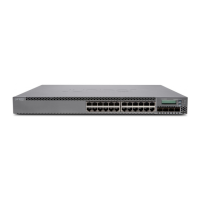
